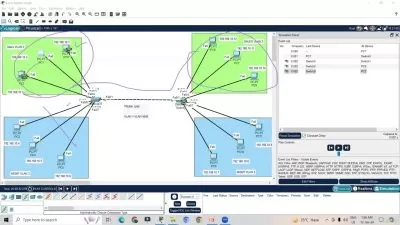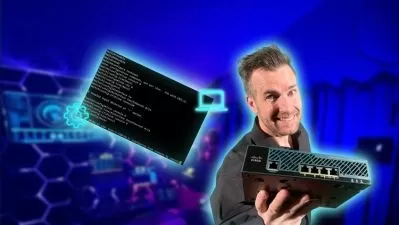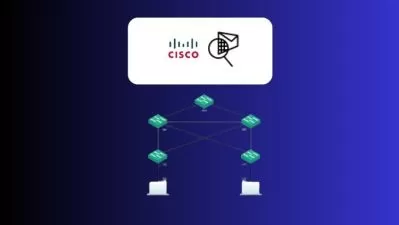Master CCNA 200-301: Ultimate Networking Certification Guide
Focused View
32:35:56
1.1 Introduction to Routers and Routing Concepts.mp4
35:02
1.2 Introduction to Switching and the Benefits of Switches.mp4
20:51
1.3 Overview of Next-Generation Firewalls, IPS, and Common Placement.mp4
17:58
1.4 Wireless Access Points and the Shift from Wired to Wireless.mp4
43:22
1.5 Controller Concepts and Overview.mp4
21:21
1.6 What Is an Endpoint.mp4
09:28
1.7 Servers, Storage, and Cloud, Oh My!.mp4
13:42
1.8 The OSI Model, Its Importance, and Tying It All Together.mp4
17:29
1.9 Frame or Packet, That IS the Question!.mp4
02:14
2.1 Three-Tier (Hierarchical) Architectures.mp4
05:59
2.2 Two-Tier (Collapsed Core) Architectures.mp4
02:21
2.3 Basic Network Design Concepts.mp4
15:22
2.4 Fabric Components.mp4
09:45
2.5 Wide Area Network (WAN) Concepts.mp4
06:26
2.6 Small OfficeHome Office (SOHO).mp4
03:50
2.7 SaaS and IaaS Infrastructure Models.mp4
08:17
3.1 Single-Mode Fiber (SMF), Multimode Fiber (MMF), Copper (RJ45 and Twisted-Pair).mp4
11:15
3.2 Connections (Ethernet Shared Media and Point-to-Point).mp4
04:15
3.3 Concepts of Power over Ethernet (PoE, PoE+, UPoE, UPoE+).mp4
09:53
4.1 MAC Learning and Aging.mp4
04:51
4.2 Frame Switching.mp4
02:04
4.3 Frame Flooding.mp4
02:10
4.4 MAC Address Table.mp4
02:22
4.5 Switching and Forwarding Lab Walkthrough.mp4
09:46
5.1 Cisco Discovery Protocol.mp4
02:58
5.2 Link Layer Discovery Protocol.mp4
04:49
5.3 CDPLLDP Lab Walkthrough.mp4
13:36
6.1 Access Ports (Data and Voice).mp4
04:55
6.2 Default VLAN.mp4
05:00
6.3 Connectivity.mp4
02:15
6.4 VLANAccess Port Lab Walkthrough.mp4
12:51
7.1 Understanding EtherChannel and EtherChannel Load Balancing.mp4
06:28
7.2 Layer 2 vs Layer 3.mp4
01:54
7.3 Link Aggregation Control Protocol (LACP).mp4
03:52
7.4 EtherChannel Lab Walkthrough.mp4
15:16
8.1 Trunk Ports.mp4
04:34
8.2 802.1Q Trunking Protocol.mp4
07:56
8.3 Native VLAN and Understanding Untagged Traffic.mp4
04:27
8.4 Trunking Overview Lab Walkthrough.mp4
08:25
9.1 Spanning Tree Overview.mp4
07:51
9.2 IEEE vs. Cisco.mp4
10:08
9.3 Spanning Tree Operations.mp4
03:06
9.4 Root Port, Root Bridge (PrimarySecondary).mp4
07:33
9.5 Designated Ports and Alternate Ports.mp4
03:40
9.6 RPVST+ Port States.mp4
02:45
9.7 PortFast Benefits and Examples.mp4
03:49
9.8 Spanning Tree Overview Lab Walkthrough.mp4
27:43
10.1 Collisions.mp4
03:03
10.2 Errors.mp4
05:33
10.3 Mismatch Duplex.mp4
06:14
10.4 Speed.mp4
07:03
10.5 Interface Statistics Lab Walkthrough.mp4
22:31
11.1 TCP.mp4
08:49
11.2 UDP.mp4
06:15
12.1 IPv4 Addressing Overview.mp4
02:32
12.2 Decimal to Binary Conversion Overview.mp4
10:58
12.3 IPv4 Network and Host Addresses.mp4
22:04
12.4 Understanding Broadcast Addresses.mp4
03:41
12.5 RFC1918 Addressing and Usage.mp4
12:18
12.6 How to Calculate Available Subnets and Available Hosts.mp4
09:26
12.7 IPv4 Subnetting Practice Drills.mp4
39:20
12.8 IPv4 Addressing and Subnetting Lab Walkthrough Part 1.mp4
13:39
12.9 IPv4 Addressing and Subnetting Lab Walkthrough Part 2.mp4
01:08
12.10 IPv4 Addressing and Subnetting Lab Walkthrough Part 3.mp4
06:37
13.1 FHRP Overview and Use Cases.mp4
07:01
13.2 HSRP, VRRP, and GLBP Overview.mp4
12:27
13.3 FHRP Routing Lab Walkthrough Part 1.mp4
19:43
13.4 FHRP Routing Lab Walkthrough Part 2.mp4
17:30
14.1 Windows Lab Walkthrough.mp4
03:26
14.2 macOS Lab Walkthrough.mp4
12:35
14.3 Linux Lab Walkthrough.mp4
04:31
15.1 Covering the Bases with RIB, FIB and Destination-based Routing.mp4
03:08
15.2 Prefixes, Routes, Summaries, and Network Masks.mp4
05:46
15.3 Next Hops, Administrative Distance, Metrics, and the Gateway of Last Resort.mp4
14:30
15.4 IP Connectivity Lab Walkthrough Part 1.mp4
25:18
15.5 IP Connectivity Lab Walkthrough Part 2.mp4
10:39
15.6 IP Connectivity Lab Walkthrough Part 3.mp4
09:00
15.7 IP Connectivity Lab Walkthrough Part 4.mp4
14:23
16.1 Longest Match.mp4
05:27
16.2 AD and Routing Protocol Metrics.mp4
06:52
17.1 Default, Network, Host, and Floating Static Routes.mp4
10:25
17.2 IPv4 Static Routing Lab Walkthrough.mp4
12:20
18.1 Neighbor Formation.mp4
08:41
18.2 Network Types.mp4
14:02
18.3 LSAs, Neighbor Adjacencies, and Router ID Significance.mp4
08:31
18.4 Single Area vs. Multi-Area, Flooding and Fault Domains.mp4
17:42
18.5 OSPFv2 Routing Lab Walkthrough Part 1.mp4
14:48
18.6 OSPFv2 Routing Lab Walkthrough Part 2.mp4
18:27
19.1 IPv6 Address Types.mp4
22:55
19.2 Static Routing for IPv6.mp4
03:23
19.3 IPv6 Address Comparison Drills.mp4
15:04
19.4 IPv6 Addressing and Prefix Lab Part 1.mp4
19:45
19.5 IPv6 Addressing and Prefix Lab Part 2.mp4
06:16
19.6 IPv6 Addressing and Prefix Lab Part 3.mp4
18:27
20.1 Typical Wireless Architectures.mp4
10:05
20.2 WLAN Physical Infrastructure Connections and Components.mp4
18:18
20.3 AP Modes.mp4
04:35
20.4 Wireless LAN Controllers.mp4
07:13
20.5 AP and WLC Management Access Connections.mp4
05:39
20.6 FlexConnect and EWC.mp4
08:03
21.1 Wireless Security Protocols (WPA, WPA2, and WPA3).mp4
13:13
21.2 WLC Walkthrough Demo Part 1.mp4
13:08
21.3 WLC Walkthrough Demo Part 2.mp4
13:50
22.1 NAT Translation.mp4
09:10
22.2 Dynamic NAT Configuration.mp4
08:55
22.3 Port Address Translation (PAT).mp4
06:35
22.4 NAT Lab Walkthrough Part 1.mp4
08:34
22.5 NAT Lab Walkthrough Part 2.mp4
06:58
22.6 NAT Lab Walkthrough Part 3.mp4
06:27
23.1 Network Time Accuracy, ClientServer Mode Operations, and Stratum.mp4
15:10
23.2 NTP Lab Walkthrough.mp4
12:25
24.1 DHCP Messages, Operations, Configuration, Client, and Relay.mp4
11:15
24.2 DHCP Lab Walkthrough.mp4
15:43
25.1 Port 53.mp4
01:46
25.2 DNS Functionality.mp4
01:59
26.1 SNMP Use Cases and Benefits.mp4
09:31
26.2 Configuring SNMP.mp4
05:29
26.3 Enabling SNMP Traps.mp4
03:18
26.4 SNMP Walkthrough.mp4
15:39
27.1 Facilities and Levels.mp4
03:19
27.2 Server Configuration, Traps, and the logging buffered Command.mp4
08:20
27.3 SYSLOG Lab Walkthrough.mp4
21:16
28.1 QoS Fundamentals.mp4
42:58
28.2 Per Hop Behavior (PHB) and Drop Probability Explained.mp4
08:52
28.3 QoS Models for Classification.mp4
10:25
28.4 QoS Congestion Management and Avoidance.mp4
21:16
28.5 QoS Lab.mp4
21:12
29.1 SSH Fundamentals.mp4
03:07
29.2 SSH Lab Walkthrough.mp4
15:03
30.1 FTP, SFTP, and TFTP.mp4
04:34
30.2 IP Services Lab Walkthrough.mp4
06:18
31.1 Threats and Vulnerabilities.mp4
10:40
31.2 Mitigation Techniques.mp4
06:58
32.1 User Security Awareness.mp4
05:08
32.2 End User Training.mp4
08:07
32.3 Physical Security and Access Control.mp4
06:45
32.4 Device Access Control Using Local Usernames and Passwords.mp4
13:34
33.1 Password Management.mp4
05:18
33.2 Complexity.mp4
06:31
33.3 Password Alternatives.mp4
05:38
34.1 Remote Access.mp4
05:04
34.2 Site-to-Site VPNs.mp4
11:59
35.1 Standard, Extended, and Named ACLs.mp4
09:29
35.2 ACL Use Cases.mp4
10:50
35.3 ACL Lab Walkthrough.mp4
21:23
36.1 DHCP Snooping and Dynamic ARP Inspection (DAI).mp4
05:20
36.2 Port Security.mp4
08:34
36.3 DAI Lab Walkthrough.mp4
10:51
36.4 Port Security Lab Walkthrough.mp4
15:02
37.1 AAA Overview.mp4
04:03
37.2 AAA Lab Walkthrough.mp4
12:01
38.1 Traditional vs. Controller-based Networks.mp4
07:01
38.2 Northbound and Southbound APIs.mp4
04:29
38.3 Software-Defined Architectures (Overlay, Underlay, and Fabric) Part 1.mp4
23:04
38.4 Software-Defined Architectures (Overlay, Underlay, and Fabric) Part 2.mp4
22:27
38.5 Control Plane, Data Plane, and Management Plane.mp4
08:54
39.1 Inventory, Design, and Provisioning.mp4
14:03
39.2 Device Management and Software Image Management (SWIM).mp4
07:19
39.3 Assurance and Application Policy (QoS).mp4
14:07
39.4 Cisco Catalyst Center Walkthrough Part 1.mp4
19:26
39.5 Cisco Catalyst Center Walkthrough Part 2.mp4
22:16
39.6 Cisco Catalyst Center Walkthrough Part 3.mp4
25:17
40.1 Automation and Network Programmability Overview Part 1.mp4
30:24
40.2 Automation and Network Programmability Overview Part 2.mp4
15:42
40.3 API Fundamentals.mp4
09:03
40.4 CRUD Functions.mp4
06:04
40.5 HTTP Verbs and Response Codes.mp4
19:51
40.6 Data Encoding Formats Part 1.mp4
15:01
40.7 Data Encoding Formats Part 2.mp4
09:21
40.8 On-Box vs. Off-Box Automation Tools.mp4
25:33
40.9 On-Box vs. Off-Box Automation Tools Lab Walkthrough.mp4
23:40
40.10 Introduction to Ansible.mp4
12:36
40.11 Introduction to Terraform.mp4
21:27
CCNA 200-301 Introduction.mp4
01:07
CCNA 200-301 Summary.mp4
00:29
Learning objectives.mp4
00:53
Learning objectives (1).mp4
00:42
Learning objectives (2).mp4
00:35
Learning objectives (3).mp4
00:32
Learning objectives (4).mp4
00:24
Learning objectives (5).mp4
00:31
Learning objectives (6).mp4
00:28
Learning objectives (7).mp4
00:27
Learning objectives (8).mp4
00:46
Learning objectives (9).mp4
00:34
Learning objectives (10).mp4
00:25
Learning objectives (11).mp4
00:53
Learning objectives (12).mp4
00:30
Learning objectives (13).mp4
00:26
Learning objectives (14).mp4
00:33
Learning objectives (15).mp4
00:21
Learning objectives (16).mp4
00:21
Learning objectives (17).mp4
00:34
Learning objectives (18).mp4
00:24
Learning objectives (19).mp4
00:37
Learning objectives (20).mp4
00:25
Learning objectives (21).mp4
00:31
Learning objectives (22).mp4
00:25
Learning objectives (23).mp4
00:23
Learning objectives (24).mp4
00:22
Learning objectives (25).mp4
00:28
Learning objectives (26).mp4
00:28
Learning objectives (27).mp4
00:30
Learning objectives (28).mp4
00:19
Learning objectives (29).mp4
00:22
Learning objectives (30).mp4
00:21
Learning objectives (31).mp4
00:33
Learning objectives (32).mp4
00:20
Learning objectives (33).mp4
00:21
Learning objectives (34).mp4
00:25
Learning objectives (35).mp4
00:25
Learning objectives (36).mp4
00:21
Learning objectives (37).mp4
00:34
Learning objectives (38).mp4
00:30
Learning objectives (39).mp4
00:50
Module Introduction.mp4
00:34
Module Introduction (1).mp4
00:44
Module Introduction (2).mp4
00:46
Module Introduction (3).mp4
00:23
Module Introduction (4).mp4
00:57
Module Introduction (5).mp4
00:40
Module Introduction (6).mp4
00:22
More details
Course Overview
This comprehensive course prepares you for the CCNA 200-301 certification exam, covering essential networking concepts, protocols, and hands-on skills to excel in modern IT infrastructure.
What You'll Learn
- Master Cisco networking fundamentals and architectures
- Configure and troubleshoot IPv4/IPv6 networks
- Implement security and automation in network environments
Who This Is For
- Aspiring network engineers seeking CCNA certification
- IT professionals upgrading their networking skills
- Tech enthusiasts pursuing careers in infrastructure
Key Benefits
- 117+ hours of focused exam preparation
- Real-world networking scenarios and labs
- Updated content aligned with 2nd Edition standards
Curriculum Highlights
- Network Fundamentals and Access
- IP Connectivity and Services
- Security and Automation Essentials
Focused display
Category
- language english
- Training sessions 222
- duration 32:35:56
- Release Date 2025/05/26







